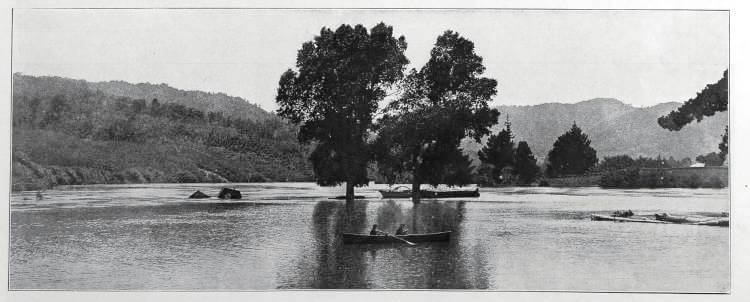A record rainfall swelled the Waikato and Waipā Rivers to their highest levels since the last big flood in 1875.
The Waikato River, already higher than usual due to snow water coming down from the higher reaches, rose quickly with the heavy rainfall. Not much attention was paid until the waters began to assume a serious aspect.

Two floods in one 1907
The old Waipā Bridge at Whatiwhatihoe was washed away from one end and swung over on to the far side of the river, being held by only one cable. Had the bridge been taken down the river it was probable that the bridges at Te Rore, Whatawhata, Ngāruawāhia and Tūākau would all have been swept away. Settlers at Pirongia Mountain were cut off from the township and the five or six of them who supplied the dairy factory had to dump their milk. Farmers suffered serious damage; all the oats and hay that had been cut being completely ruined – stocks of oats were left looking like heaps of black soil. The Puniu and Mangaohoi rivers were in high flood, all low-lying lands being covered, and in some cases settlers’ homes were surrounded by water. The excessive rain also brought back potato blight, and it was feared there could be a famine as supplies of bread, flour and meat ran short.
At Ōhaupō the so-called footpath from the hotel to the public hall was no better than a sheep track, and in wet weather was dangerous to walk along. A person going to the hall to attend a concert fell over some projecting roots on the path and broke an arm. Other slight mishaps also occurred frequently. The main thoroughfare was utterly impassable.
The roadway had been ploughed up and limestone metal laid down which made it very disagreeable to walk over. People going to the railway station had to wade through mud or stumble over rough metal until they met a horse and trap of some sort, and then had to stop in ankle deep mud to let it pass.
The new Paterangi school teacher, Mrs Bates, opened school but owing to the prevalence of measles and influenza, only two scholars put in an appearance. Paterangi meanwhile was advancing with the times. The timber for a new post and telegraph office was on the ground, and the farmers hoped to have everything in readiness for the new post mistress, Miss Gordon, to take up her duties.
The Anglican, Methodist and Presbyterian Sunday schools planned a combined annual picnic. Each school would cater for its own scholars in regard to refreshment, but a general sports committee would arrange games in which all children could take part. Arrangements were to be made to supply hot water to visitors.
Mr Reynolds kindly gave permission for the picnic to be held on his splendid property at Mangapiko known as The Norwegians. The teachers were relying on the help of their friends having vehicles to assist in the conveyance of the little ones.









